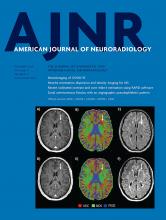Acute necrotizing encephalopathy (ANE) is a rare subtype of acute infectious encephalopathy, first described by Mizuguchi,1 a Japanese pediatric neurologist, in 1995. The clinical characteristics of ANE include febrile illness followed by altered consciousness and seizures. The pathologic features of the disease are necrosis and multiple petechiae in both the thalamus and tegmentum of the pons, as well as myelin pallor in the cerebral and cerebellar deep white matter. ANE typically develops in children younger than 5 years of age; only case reports have been published thus far in adults. In this issue of the American Journal of Neuroradiology, the authors report the clinical and radiologic findings of ANE in 10 adults and draw attention to several important aspects of the disease that should be recognized.2
The authors discuss the similarities and differences in MR imaging findings of ANE between children and adults. Thalamic involvement is a key radiologic finding for ANE diagnosis, regardless of patient age. A feature specific to ANE is the trilaminar pattern of restricted diffusion seen in the ADC map,3 which was detected in all patients in this report. Whereas the core of the thalamic lesion shows high signal intensity, the adjacent pericore lesions show low signal intensity. The outer lesions also show high signal intensity on the ADC map. This characteristic neuroimaging pattern corresponds well with the pathologic findings reported previously.4 Whereas the center of the thalamic lesion suggests hemorrhagic necrosis, the periphery of the core lesion suggests cytotoxic edema and the outside portions thalamic lesion vasogenic edema. Among the observed differences between ANE in adults and children, the authors report higher white matter (89%) and cerebellar (100%) involvement, in addition to parenchymal hemorrhage (90%), in adults. Our previous study of pediatric ANE found cerebellar lesions in only 23% of affected children.5 The reason for the higher occurrence rate in adults than children is not considered in detail by the authors, but it may reflect differences in infectious agents, genetic background, immune response, and age-specific tissue vulnerability. However, in the study of Okumura et al,5 there were no differences in clinical symptoms, laboratory data, or outcomes between children with ANE who had developed influenza and those who did not, suggesting that the pathogenetic mechanism of ANE is not dependent on an infectious agent. Further investigations are needed to determine the reasons for the different MR imaging findings between children and adults with ANE.
Another interesting aspect of this study is the history of underlying infection because the authors identified dengue in 3 of the 10 patients. However, the study was retrospective and conducted in a single center (part of a medical school hospital in South India). Dengue is a mosquito-borne viral disease endemic in all tropical and subtropical countries, including South India. Although influenza virus is the most common pathogen in ANE, even in adults, other infectious agents, including human herpesvirus-6, herpes simplex virus, parvovirus B19, measles, rotavirus, Mycoplasma infection, and Streptococcus pneumoniae infection, can lead to the same pathologic condition that results in ANE in children. However, dengue virus belongs to the flaviviruses, which have rarely been reported as causal pathogens in ANE. We identified only 1 case report of ANE in which dengue was the antecedent infection; the patient was a 15-year-old girl in Pakistan.6 Neurologic involvement resulting from dengue infection is uncommon, developing in only 4%–5% of patients. The neurologic manifestations include encephalopathy, acute disseminated encephalomyelitis, and dengue muscle dysfunction.7 Vanjare et al8 described the brain imaging patterns of patients with dengue and neurologic symptoms; a quarter of the patients had thalamic involvement. Another study reported a series of adult patients with dengue infection, as well as clinical and radiologic findings mimicking ANE.9 The clinical and radiologic findings of these patients should be carefully evaluated to determine whether they meet the diagnostic criteria of ANE. Nevertheless, dengue should be suspected as the antecedent virus in patients with ANE residing in dengue-endemic regions.
As of August 2020, the COVID-19 pandemic continues largely unabated. Although affected patients typically present with fever, cough, and respiratory distress, accumulating evidence suggests that 30%–40% have neurologic complications, including stroke, encephalopathy, encephalitis, and meningitis.10,11 Recent case reports have clearly demonstrated that Severe Acute Respiratory Syndrome coronavirus 2 (SARS-CoV-2) infection can also cause ANE, particularly in adults.12⇓-14 The neuroinvasive and neurotropic abilities of SARS-CoV-2 are well established and have been attributed to the angiotensin-converting enzyme 2 receptor, expressed abundantly on venous endothelial cells and arterial smooth muscle cells in the brain. The virus directly accesses the brain via the nasal mucosa, lamina cribrosa, and olfactory bulb or via retrograde axonal transport. A proinflammatory and prothrombotic cascade develops in the wake of the virus-induced cytokine storm, a hyperinflammatory state that is also the central pathogenesis in patients with ANE, regardless of the causal agent. Both the brain vasculature and blood–brain barrier are affected, with edema and necrosis as secondary effects.
Immunosuppressive treatments, including methylprednisolone pulse therapy, and plasmapheresis may lead to favorable outcomes in some patients with ANE. A possible therapeutic target is the interleukin-6-STAT3 pathway, which has been shown to be responsive to tocilizumab, a monoclonal antibody against the interleukin-6 receptor.15 Prompt diagnosis of ANE based on characteristic MR imaging findings is essential, but improved treatment strategies are required.
References
- © 2020 by American Journal of Neuroradiology












